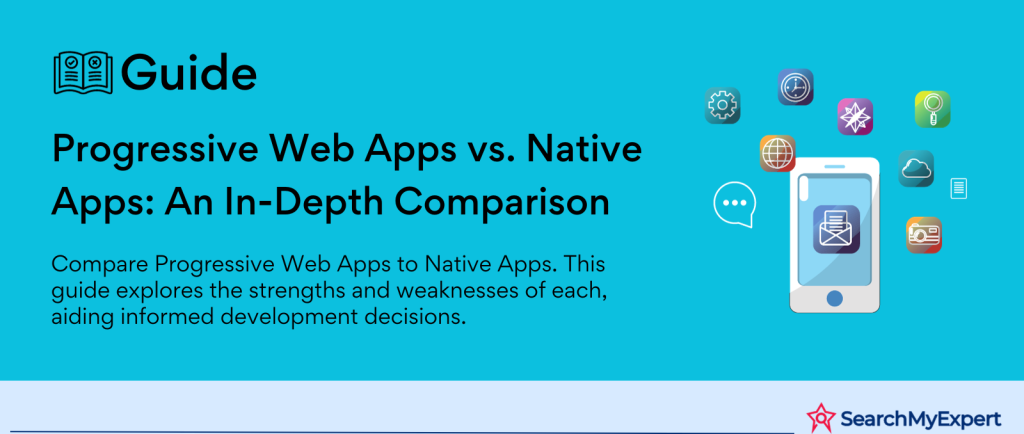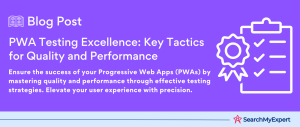Progressive Web Apps (PWAs) vs. Native Apps
In the ever-evolving digital landscape, the debate between Progressive Web Apps (PWAs) and Native Apps is intensifying. As technology advances, so does the way we interact with the digital world, particularly through the apps we use daily. Understanding the nuances of PWAs and Native Apps is crucial for businesses, developers, and users alike. This comparison aims to shed light on these two types of apps, helping readers make informed decisions based on their specific needs.
What are Progressive Web Apps (PWAs)?
Progressive Web Apps are a hybrid between regular web pages and mobile applications. They are built using standard web technologies like HTML, CSS, and JavaScript but offer a user experience that rivals native applications. PWAs are designed to be fast, reliable, and engaging. They work on any device with a standard browser, making them universally accessible. One of their key features is the ability to work offline or with a poor internet connection, thanks to service workers who cache important resources. PWAs are installable on the home screen, can send push notifications, and offer a full-screen experience.
What are Native Apps?
Native Apps, on the other hand, are developed specifically for a particular mobile operating system, such as iOS or Android. They are built using platform-specific programming languages like Swift for iOS or Kotlin for Android. These apps can directly access the hardware of the device, such as the GPS, camera, and microphone, offering optimized performance and a richer user experience. Native Apps are downloaded and installed through app stores like Apple’s App Store or Google Play Store.
The Rise of Progressive Web Apps
The growing popularity of PWAs can be attributed to several factors. Firstly, they reduce the barrier to entry for users, as there’s no need to download and install from an app store. This ease of access can lead to higher user engagement. Secondly, for businesses, PWAs are cost-effective as they are developed once and run everywhere, eliminating the need for separate codebases for different platforms. Lastly, the performance enhancements and offline capabilities of PWAs have significantly closed the gap with native apps in terms of user experience.
Purpose of the Comparison
The purpose of this comparison is to provide a clear understanding of both PWAs and Native Apps. We aim to highlight their strengths and weaknesses, allowing readers to evaluate which type of app suits their particular requirements, whether it’s for business application or personal use. By the end of this guide, you’ll have a comprehensive view of both options, empowering you to make an informed choice.
Platform Availability: Progressive Web Apps (PWAs) vs. Native Apps
Platform availability is a crucial aspect to consider when comparing Progressive Web Apps (PWAs) and Native Apps. The flexibility and reach of an app can significantly impact its success and user adoption. In this section, we’ll delve into the platform compatibility of PWAs and Native Apps, exploring how their respective environments shape their usage, advantages, and limitations.
Platform Compatibility of PWAs
PWAs boast a major advantage in platform compatibility due to their web-based nature. They are accessible through web browsers on a variety of devices, including smartphones, tablets, laptops, and desktops. This cross-platform compatibility is made possible because PWAs are built using standard web technologies like HTML, CSS, and JavaScript. Users can access a PWA on any device with a browser, regardless of the operating system. This universality means that PWAs offer a broader reach without the need to develop separate versions for different platforms.
Advantages of PWA Platform Flexibility:
- Broader Audience Reach:
Since PWAs work across multiple platforms, they can reach a larger audience. - Cost-Effective Development:
Businesses save on development costs as they don’t need to create multiple versions of the app for different operating systems. - Easier Updates and Maintenance:
Updates are simpler since they are applied directly to the web-based version of the app, eliminating the need for users to download updates.
Disadvantages of PWA Platform Flexibility:
- Limited Access to Device Features:
PWAs may not have full access to device-specific features and hardware capabilities compared to native apps. - Variable Performance Across Devices:
The performance of PWAs can vary depending on the browser and device, leading to inconsistent user experiences. - Dependency on Internet Connectivity: While PWAs can work offline, their functionalities can be limited without an active Internet connection.
Platform Compatibility of Native Apps
Native Apps are developed for specific operating systems, like iOS for Apple devices and Android for Android devices. This specialization allows them to fully leverage the hardware and software capabilities of the specific platform, offering optimized performance and a richer user experience.
Advantages of Native App Platform Specificity:
- Optimized Performance:
Native Apps can directly access device hardware, leading to faster and more efficient performance. - Better Integration with Device Features:
They offer comprehensive access to device features like cameras, GPS, and sensors, enabling more advanced functionalities. - Consistent User Experience:
Native Apps provide a uniform and smooth user experience on their specific platform.
Disadvantages of Native App Platform Specificity:
- Higher Development Costs:
Separate versions need to be developed and maintained for different platforms, increasing costs. - Limited Audience Reach:
The audience is segmented based on the device’s operating system. - Frequent Updates Required:
Users need to download updates from app stores, which can be a barrier to maintaining the latest version of the app.
Development and Cost: Progressive Web Apps (PWAs) vs. Native Apps
When embarking on app development, two of the most critical factors to consider are the development process and the associated costs. The choice between Progressive Web Apps (PWAs) and Native Apps can significantly impact both. This section compares the development intricacies and financial implications of PWAs and Native Apps, providing insights into what might be the best approach for different project requirements.
Development Process and Costs of PWAs
The development of PWAs is generally streamlined and cost-effective due to their nature of using a single codebase across all platforms. This approach utilizes standard web technologies like HTML, CSS, and JavaScript, which many developers are already familiar with.
Advantages of PWA Development:
- Single Codebase for All Platforms:
A PWA can be developed once and deployed across various platforms without the need for platform-specific adaptations. This significantly reduces the time and resources required for development. - Lower Development Costs:
With a unified codebase, the overall cost of developing a PWA is typically lower than that of a native app. This is because there’s no need to hire different development teams for different platforms. - Ease of Updates:
Updating a PWA is as simple as updating a web page, and the changes are immediately visible to the user without the need for downloading updates from an app store.
Disadvantages of PWA Development:
- Limited Access to Native Features:
While PWAs have improved significantly, they still lack full access to all the native features and capabilities that a dedicated mobile operating system offers. - Performance Constraints: For complex applications requiring intense graphical and processing power, PWAs might not perform as efficiently as native apps.
Development Process and Costs of Native Apps
Native app development involves creating apps for specific platforms, primarily iOS and Android, using platform-specific languages like Swift for iOS and Kotlin or Java for Android. This approach is more resource-intensive and can lead to higher costs.
Advantages of Native App Development:
- Optimized Performance and Capabilities: Native apps can fully harness the power of the specific platform, offering high performance and access to all native features of the device.
- Better User Experience: These apps tend to provide a more seamless and integrated user experience, aligning closely with the device’s ecosystem.
Disadvantages of Native App Development:
- Higher Development Costs:
Developing separate apps for different platforms means higher costs, as it involves multiple development teams and longer development time. - More Complex Update Process: Each update must go through the respective app store’s review process, and users must manually update the app on their devices.
Performance and Features: Progressive Web Apps (PWAs) vs. Native Apps
The performance and range of features of an app play a pivotal role in user satisfaction and overall app success. In this regard, Progressive Web Apps (PWAs) and Native Apps often show significant differences. This section aims to analyze these differences, focusing on aspects such as loading times, smooth performance, and access to device capabilities.
Performance of Native Apps
Native Apps are known for their superior performance and ability to leverage the full potential of the device’s hardware. This high performance is attributed to their direct integration with the mobile operating system and the ability to access device-specific features.
Advantages of Native App Performance:
- Faster Loading Times:
Native Apps usually load faster than PWAs. This is because they are installed directly on the device and can efficiently utilize the device’s processing power. - Smoother Performance:
With direct access to the device’s hardware and resources, native apps can offer a more fluid and responsive user experience. This is particularly noticeable in apps requiring intensive graphics or processing power. - Advanced Functionalities:
Native Apps have the advantage of accessing all the features offered by the device’s operating system, such as push notifications, camera, GPS, accelerometer, and more. This allows for more sophisticated app capabilities.
Limitations of Native App Performance:
- Device and OS Dependency:
Their performance can vary depending on the device’s hardware and the version of the operating system. - Regular Updates Required:
To maintain optimal performance, native apps require regular updates, which need to be downloaded and installed by the user.
Performance of PWAs
PWAs, while having made significant strides in performance, may still face limitations compared to native apps, especially in terms of loading speed and access to device features.
Advantages of PWA Performance:
- Improved Accessibility:
PWAs are easily accessible via web browsers, making them readily available to a wider audience without the need for downloading and installing. - Offline Functionality:
Service workers in PWAs allow them to work offline or in low-network conditions, a significant advantage in terms of accessibility.
Limitations of PWA Performance:
- Variable Performance Across Devices:
Since PWAs depend on the browser and the quality of the internet connection, their performance can be inconsistent across different devices and network conditions. - Limited Access to Native Features:
PWAs do not have full access to all the device-specific features and capabilities that native apps can utilize. This can limit the range of functionalities PWAs can offer. - Dependence on Web Technology: The reliance on web technologies may restrict PWAs in terms of processing speed and responsiveness compared to native apps, especially for complex tasks.
Offline Functionality and User Experience: Progressive Web Apps (PWAs) vs. Native Apps
In today’s mobile-centric world, the ability of an app to function offline and provide an engaging user experience is highly valued. This aspect often influences the choice between Progressive Web Apps (PWAs) and Native Apps. Let’s delve into how these two types of apps compare in terms of their offline capabilities and the overall user experience they offer.
Offline Capabilities of PWAs
PWAs have made significant advancements in offline functionality, primarily through the use of service workers. These are scripts that run in the background, separate from the web page, and enable PWAs to load content, cache resources, and function offline.
Advantages of PWA Offline Capabilities:
- Service Workers:
These allow PWAs to cache important resources, enabling the app to load and function during low or no network conditions. - Content Availability: PWAs can store content for later use, which is particularly beneficial in areas with unstable internet connections.
Limitations of PWA Offline Capabilities:
- Limited Storage:
The amount of data a PWA can cache is usually less than what a native app can store, potentially limiting the offline functionality. - Dependence on Browser Capabilities:
The effectiveness of offline functionality in PWAs can vary depending on the browser’s capabilities and limitations.
Offline Capabilities of Native Apps
Native Apps generally offer more robust offline capabilities. They can store larger amounts of data locally and utilize device-specific features to enhance offline performance.
Advantages of Native App Offline Capabilities:
- Greater Data Storage:
Native apps can store more data on the device, allowing for more extensive offline functionality. - Deep Integration with Device:
This allows native apps to perform complex tasks and retain user preferences even when offline.
User Experience Differences
The user experience offered by PWAs and Native Apps can vary significantly, influenced by their design, responsiveness, and overall engagement.
Responsiveness and Design:
- PWAs: They are responsive and adaptable to various screen sizes, similar to responsive websites. However, the level of responsiveness can depend on the browser and the device.
- Native Apps: Known for their smooth and responsive design, native apps provide a seamless experience that aligns closely with the device’s operating system.
Intuitive User Interface:
- PWAs:
They offer a user interface similar to native apps but may sometimes fall short in terms of fluidity and intuitive design, especially on complex interactions. - Native Apps: Typically feature a more intuitive and user-friendly interface, taking full advantage of the device’s native UI components.
Overall Engagement:
- PWAs:
The ease of access without the need for downloading can lead to higher initial engagement. However, maintaining user engagement over time can be challenging. - Native Apps:
With advanced features and better performance, native apps often see higher long-term user engagement.
Progressive Web Apps (PWAs) vs. Native Apps
As we reach the conclusion of our comprehensive comparison between Progressive Web Apps (PWAs) and Native Apps, it’s essential to summarize their key characteristics, strengths, and weaknesses. This summary will aid in making an informed decision on which type of app best suits your specific needs.
Key Points of Comparison
StrenPlatform Availability: PWAs offer cross-platform compatibility through web browsers, while native apps require separate development for each operating system.
- Development and Cost:
PWAs generally entail lower development costs and time due to a single codebase for all platforms. In contrast, native apps involve higher costs and longer development times due to platform-specific development. - Performance and Features: Native apps typically provide superior performance and full access to device hardware features. PWAs, while improving, may have limitations in performance and access to certain device features.
- Offline Functionality:
Both PWAs and native apps can offer offline capabilities, but native apps tend to provide more extensive offline functionality and data storage. - User Experience:
Native apps usually deliver a more seamless and intuitive user experience, closely integrated with the device’s ecosystem. PWAs are improving in this area but may not yet match the fluidity and responsiveness of native apps.
Strengths and Weaknesses
- PWAs:
Their strengths lie in broader platform reach, cost-effectiveness, and ease of updates. However, they can fall short in terms of performance, offline capabilities, and access to native device features. - Native Apps:
Known for their optimized performance, advanced features, and superior user experience. The trade-offs include higher development costs and the need for separate development for different platforms.
Recommendation
When deciding between PWAs and native apps, consider the following factors:
- App’s Purpose and Required Features:
If the app requires intensive use of device features, or if performance is a priority, a native app is advisable. For less complex apps or those prioritizing wide accessibility, a PWA may be sufficient. - Target Audience:
For a broad, platform-agnostic audience, PWAs are ideal. If your audience is concentrated on a specific platform (iOS or Android), a native app might be more beneficial. - Budget and Resources:
PWAs are more budget-friendly and require fewer resources for development and maintenance. Choose native apps if the budget allows for more extensive development and a focus on a high-end user experience.
Conclusion:
In the dynamic world of app development, the choice between Progressive Web Apps (PWAs) and Native Apps is pivotal. This guide has provided a thorough comparison across various critical aspects: platform availability, development and cost, performance, offline functionality, and user experience. PWAs stand out for their cross-platform compatibility, cost-effectiveness, and ease of maintenance. In contrast, Native Apps excel in performance, feature richness, and user experience, tailored to specific operating systems.
Stand out with innovative PWAs from our Progressive Web App Service Firms.
Table of Contents
Toggle






